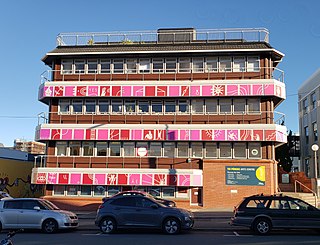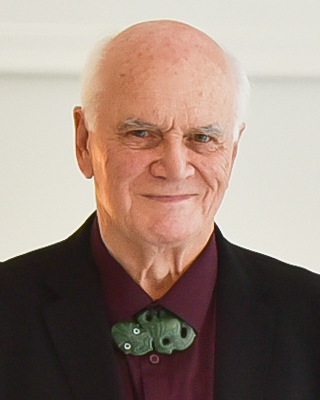Related Research Articles

The Toi PōnekeArts Centre, is the New Zealand capital's creative production facility and support complex. It was established between 2003 and 2005, and was formally opened by Mayor Kerry Prendergast in July 2005. For twelve years previous, the city's arts centre had been based at the much smaller Oriental Bay Rotunda. The new complex, spread across two buildings and seven floors, has a focus on active creative production in all disciplines, and on the further advancement of cultural identity in New Zealand. It is located in the bustling and dynamic Upper Cuba Street neighbourhood of Wellington.

Toi Whakaari: NZ Drama School is New Zealand's national drama school. It was established in 1970 and is located in Wellington, New Zealand in the Te Whaea: National Dance & Drama Centre. Toi Whakaari offers training in acting, costume construction, set and props construction, performing arts management and design for stage and screen. Toi Whakaari has a roll of approximately 130 students annually, who study for up to three years.
Huia Publishers is a New Zealand publishing company based in Wellington, established in 1991. Huia publishes material in Māori and English for adults and children, including graphic novels, picture books, chapter books, novels and resources for kura kaupapa Māori.

The Ministry for Culture and Heritage is the department of the New Zealand Government responsible for supporting the arts, culture, built heritage, sport and recreation, and broadcasting sectors in New Zealand and advising government on such.

The New Zealand Māori Arts and Crafts Institute (NZMACI) is an indigenous traditional art school located in Rotorua New Zealand. It operates the national schools of three major Māori art forms.
Toi Māori Aotearoa is a charitable trust that promotes Māori traditional arts and Māori artists, both in New Zealand and overseas.

Te Roopu Raranga Whatu o Aotearoa or Māori Weavers New Zealand is the New Zealand national Māori weavers’ collective, which aims to foster and preserve Māori traditional textiles. It has played an important role in facilitating the gathering of weavers of Māori and Pasifika descent to meet, teach and learn from one another.
Diggeress Rangituatahi Te Kanawa was a New Zealand Māori tohunga raranga of Ngāti Maniapoto and Ngāti Kinohaku descent. At the time of her death she was regarded as New Zealand's most renowned weaver.
Manos Ross Nathan was a New Zealand ceramicist.

Chris Bailey is a Māori sculptor and carver. Bailey studied Māori language and Māori material culture at the University of Auckland under Dante Bonica. He lives and works on Waiheke Island.
Arts Access Aotearoa was established as a charitable trust in 1995 with funding from Creative New Zealand. It was created primarily to meet a key objective of the Arts Council of New Zealand Toi Aotearoa Act 1994: that is, to support "the availability of projects of merit to communities or sections of the population that would otherwise not have access to them". Arts Access Aotearoa’s main areas of focus are supporting disabled people to create and participate in art of all kinds; encouraging performing arts companies, venues, producers and artists to increase their accessibility; and facilitating arts-based rehabilitative projects and programmes in prisons. It receives core funding from Creative New Zealand and has a major contract with the Department of Corrections. It also has support and sponsorship from local government, philanthropic trusts and businesses around New Zealand.
AotearoaNew Zealand Festival is a multi-arts biennial festival based in Wellington New Zealand that started in 1986. Previous names are the New Zealand International Festival of the Arts, New Zealand International Arts Festival, New Zealand Arts Festival and New Zealand Festival of the Arts. The festival is produced every two years and runs across three weeks in venues in Wellington City and outreach programmes in the region. The festival features both international and national acts from performing arts and music with a literary programme also.

Te Awahou Nieuwe Stroom is a multi-cultural, multi-purpose visitor and community hub in Foxton, in the southern part of New Zealand's North Island. The facility hosts some 150,000 users annually - to visit the Maori and Dutch museums, the library or the community rooms, the gallery or the heritage room. Locals take care of their affairs in the Council Service Centre.

Raymond Henry "Sandy" Adsett is a New Zealand visual artist and educator. He is acknowledged for championing the art of kōwhaiwhai painting, creating a context for the artform within the development of contemporary Māori art.

Performing arts in New Zealand include amateur and professional presentations of theatre, circus, dance and music where it accompanies live performance. Aotearoa New Zealand has an active contemporary performing arts culture; many people participate in performing arts activities and most people live near an arts centre or theatre building.
Dance Aotearoa New Zealand (DANZ) is the national support organisation for dance in New Zealand, founded in 1993. It is a not-for-profit, with a stated mission "to make dance visible" through "the promotion of dance and the provision of services to the dance sector in all its diversity." In 2019 it failed to gain funding from Creative New Zealand and sought a judicial review of the funding decision in 2021.

The Pacifica Mamas Arts and Cultural Trust is an arts collective based in Auckland, New Zealand, with the mission to pass on traditional Pacific arts. The arts collective are based at the Pacifica Arts Centre, located in the Corban Estate Arts Centre.

Misa Emma Kesha is a Samoan master weaver based in Dunedin, New Zealand, who has received awards for her contribution to the arts, Pacific communities and weaving in New Zealand.

Selwyn Frederick Muru, also known as Herewini Murupaenga, was a New Zealand artist. Of Māori descent, his life's work included painting, sculpture, journalism, broadcasting, directing, acting, set design, theatre, poetry, and whaikōrero. Muru was awarded the Te Tohu Aroha mō Te Arikinui Dame Te Atairangikaahu | Exemplary/Supreme Award in 1990 at the Creative New Zealand Te Waka Awards.
References
- 1 2 3 Durrant, Martin (22 October 2014). "Arts funding and support". Te Ara - the Encyclopedia of New Zealand.
- ↑ "What is MASPAC?". Tu Tangata (14): 40. 1 October 1983.
- 1 2 Kesha, Misa Emma. ""Whatever your hand finds to do, do it with all your might."". Pantograph Punch. Retrieved 5 June 2023.
- ↑ "Te Roopu Raranga Whatu o Aotearoa". New Zealand history online. Retrieved 5 June 2023.
- 1 2 3 4 5 6 7 Wenley, James. "Everything you ever wanted to know about Creative New Zealand and Arts Funding in Aotearoa". Theatre Scenes: Aotearoa New Zealand Theatre. Retrieved 5 June 2023.
- 1 2 Wenley, James (17 October 2022). "The fuss over Shakespeare is a distraction from the real scandal of arts funding". Stuff. Retrieved 5 June 2023.
- ↑ "Annual Report 2014/15". www.creativenz.govt.nz. Retrieved 2 September 2016.
- ↑ "A Brief History of Government Involvement in Culture, Ministry for Culture and Heritage" . Retrieved 13 May 2008.
- ↑ "Arts Council of New Zealand Toi Aotearoa Act 2014 No 1, Public Act Contents". New Zealand Legislation . 31 January 2014. Retrieved 26 July 2017.